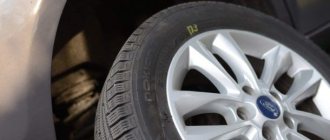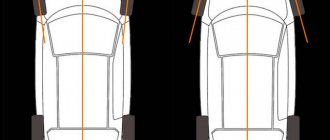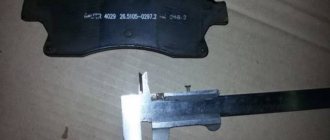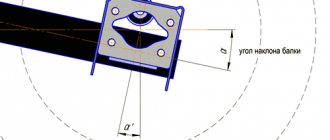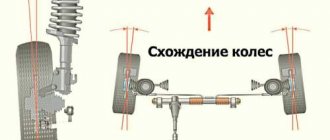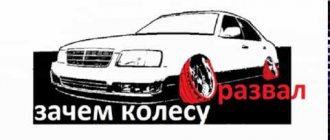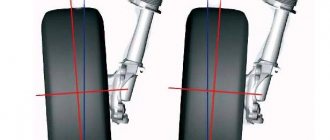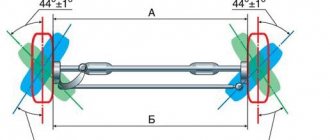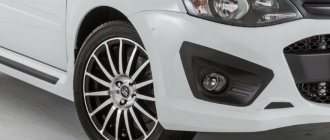The chassis of a vehicle is rightfully considered a complex unit where the elements are connected to each other. The suspension provides a comfortable ride and affects the safety of the car. If the car's suspension system is capricious, it negatively affects handling. The car handles worse on the road and loses maneuverability.
The problems mentioned above fully relate to the car's depreciation system. Today, our goal is to find out whether it is necessary to do a wheel alignment after replacing shock absorbers.
Which wheel alignment stand to choose?
I would like to note that it does not matter which stand you ultimately choose, computer or optical (laser). The main thing is what kind of master “breaker” will do it
A good and experienced master will do equally well on any stand, if he is a true professional, i.e. treats his profession and his equipment with soul and love. The stand of such a master is always precisely calibrated and you can safely entrust your car to him. The main difference between an optical stand and a computer stand is the accuracy of measurement. The advantage of an optical stand is that it is simpler in design and, as a result, more reliable in operation. The downside is that the optical stand can simultaneously diagnose only one of the axes, front or rear. If we make the front axle, then we will miss an important parameter, the angle error of the rear axle. The rotation of the rear axle directly affects the driving angle, stability and controllability of the vehicle. Therefore, when making adjustments on the optics, you need to take into account the likelihood that the steering wheel will have a slight tilt when the car is moving in a straight line. The computer stand is more accurate in measurements and does not have the disadvantage of one axis and can diagnose two bridges simultaneously. Because the adjustment takes place along two axes simultaneously, their location relative to the axis of symmetry of the car is taken into account, and if the car was in an accident and the geometry of the body is broken, then an experienced specialist will immediately determine this
It is worth noting that all this applies only to modern computer stands with a closed measurement loop. Old stands have an open circuit, as well as outdated software
Therefore, immediately pay attention to what equipment is available at the service station. A modern computerized wheel alignment stand allows you to get the adjustment results in printed form. Such a report will contain certain parameters and definitions. Let's explain some basic parameters.
How does the wheel alignment work?
Let's look at the main features of adjusting the rear wheels, depending on the type of stand used. Optical stand. When adjusting wheel alignment using it, optical beams are projected onto two special screens on which diagnostic marks are applied. There is a hole in the center of each mark. The car is positioned between these screens, and small mirrors are attached to its wheels. During adjustment, optical rays are reflected from the mirrors on the wheels and hit the screens. Based on the distance between the hole in the control mark and the place where the beam hits the screen, the required wheel alignment angle is determined. If the optical stand is well calibrated, and the adjustment is made by a sufficiently qualified mechanic, then the result of the adjustment will be satisfactory. Computer stand. Increasingly, computerized stands are being used at service stations, allowing wheel alignment adjustments to be made faster and with much greater accuracy. When using them, electronic sensors are attached to the wheels, which transmit information to the head unit using a radio signal or a laser beam. The angle of rotation during camber and toe, the relative position of the wheels and the overall geometry of the suspension are recorded on the monitor and memorized by the computer, after which they can be printed and used by the master for adjustment. Computer 3D stand. The most modern diagnostic method. Special reflective targets are attached to the wheels. Digital cameras connected to a computer track their movements, and the received information is instantly processed by the processor. Camber and toe are determined very quickly: you just need to turn the steering wheel to the sides, and also roll the car forward and back a short distance.
I changed the struts, do I need to do a camber?
The chassis of a vehicle is rightfully considered a complex unit where the elements are connected to each other. The suspension provides a comfortable ride and affects the safety of the car. If the car's suspension system is capricious, it negatively affects handling. The car handles worse on the road and loses maneuverability.
The problems mentioned above fully relate to the car's depreciation system. Today, our goal is to find out whether it is necessary to do a wheel alignment after replacing shock absorbers.
A few words about safety
More than the suspension, the only thing that affects driving safety is the brakes. To avoid getting into trouble, monitor their condition - change the pads on time and constantly check the amount of brake fluid. After replacing the pads, you need to bleed the brakes - this is not the law, but it’s safer and you’ll have peace of mind.
Keep an eye on the important components of the car - suspension, steering, brakes. A timely visit to the specialist will save you from many problems and costs.
When you feel that the car is not behaving normally, contact the station immediately, even if it is just a suspicion. It’s better to play it safe – it will get worse later. Timely maintenance will save you from accidents and the costs of future repairs.
If you find an error, please select a piece of text and press Ctrl+Enter.
What does an incorrect alignment lead to?
The topic of wheel alignment is constantly discussed on automobile forums. Urgent “technical treatment” is necessary when car rims point in different directions. Exactly like an unloaded Tatra. Unlike a Czech truck, the handling of a passenger car is significantly reduced. The thing is that refusal to perform wheel alignment threatens with serious troubles, which we will talk about a little later.
Experts say that in the work of well-coordinated mechanisms it is necessary to find a compromise. Goal: to set optimal operating parameters for all nodes.
When it comes to adjusting the steering wheel angles, it is important to decide and find the average:
- Vehicle stability.
- Controllability of machine control.
This is a compromise, or, if you like, a technical balance. Most often, the disks located in front correspond to the four most important indicators:
- Disintegration.
- Toe-in.
- Fractional angles of repose of the rotating rod of the wheel.
- Perpendicular to angles.
What factors can affect the accuracy of measurements?
Of course, the accuracy of the procedure depends on the correctness of its implementation. Only if you strictly follow the protocol and correctly carry out all the settings can you achieve an impeccable result.
First, you need to conduct a visual inspection of all suspension elements, paying special attention to steering systems, ball struts, and silent blocks. If there are gaps, there is no point in carrying out further diagnostic procedures - the defect must first be eliminated
If there is no play, the tire pressure is checked (diagnostics on 3D stands allows you to skip this step, since the equipment independently recognizes the tire inflation level based on the outer diameter).
After this, the suspension is unloaded as much as possible, sensors are attached to the wheels of the car, and vibration compensation is performed (due to the use of uneven rims, appropriate adjustments are made to the program).
In some vehicle models, checking wheel alignment on a stand requires additional loading of the passenger compartment, equivalent to the total weight of the driver and one or two passengers. If the operator does not take this point into account, the result produced by the stand will be incorrect.
Of course, do not forget about the annual inspection of the stand itself. To ensure maximum accuracy of results, equipment must systematically undergo routine diagnostics. The platform intended to accommodate vehicles must be perfectly level and securely fastened.
When do you need to adjust toe and camber?
Adjustment of the RS can be planned or unscheduled. In the planned version, its regularity depends on the recommendations of the vehicle manufacturer. Domestic cars need a procedure every 10-15 thousand kilometers. Foreign vehicles should be shown to service station technicians after 30 thousand kilometers. When answering the question of how often to do a wheel alignment, experts advise contacting the service at least once a year. The best time is spring, when replacing winter tires.
Unscheduled adjustment procedures may be needed in the following cases:
- accelerated tire wear or tire replacement;
- spontaneous deviation of the car to the side while driving on the highway;
- side impact of the wheel on an obstacle, which causes a dent on the disk;
- replacement of chassis parts (shock absorbers, suspension arms, silent blocks and other elements);
- changing ground clearance parameters (shortening or lengthening springs);
- after a long drive on roads without high-quality surfaces;
- aggressive driving style.
Result of wheel alignment adjustment:
- increasing vehicle stability;
- improved handling;
- minimal risk of skidding;
- fuel economy;
- reduced tire wear.
CV joint replacement
The constant velocity joint is not part of the suspension and does not affect it, but when replacing it, the angle of the wheels is always adjusted.
When they take out the CV joint, they disassemble the fastening of the steering tip or ball joint. After installing a new part, the tip is twisted, which throws off its settings. Often it is completely broken. And if you don’t align, the car will drive to the side.
The angle of inclination of the wheels is also influenced by the condition of the steering tip itself. When replacing it or repairing the steering rack, the camber is also adjusted.
